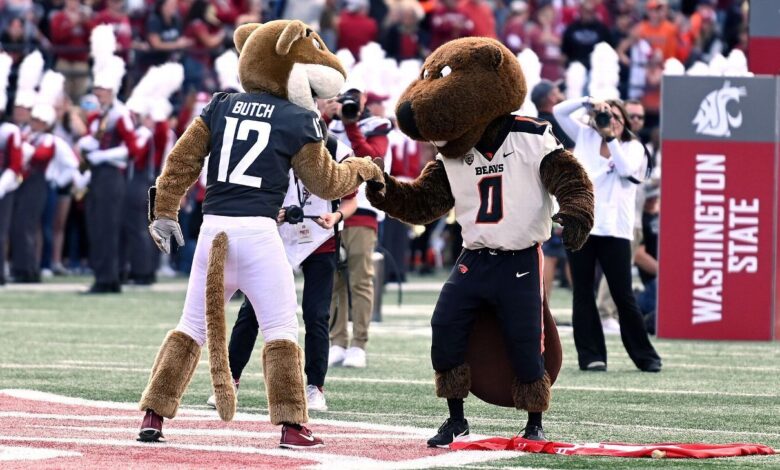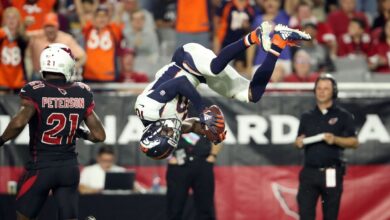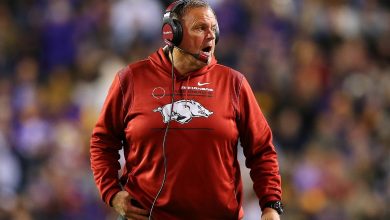The Pac-12 leftovers – What will be Washington State’s and Oregon State’s ultimate fate?

PULLMAN, Wash. — Nothing about Saturday’s game between Oregon State and Washington State should have felt unusual. There is a familiarity that comes with having played 106 times over the past 120 years.
It’s a rivalry game in that sense. A reliable way to mark the passage of time. But this version — the first time the matchup featured both teams in the AP top 25 — might have had the friendliest lead-up to a high-stakes college football game on record.
The pregame festivities were highlighted by the schools’ mascots — Benny Beaver and Butch T. Cougar — being driven onto the field in a cart, waving each other’s flag, before sharing a dance at midfield. The WSU Cougar Marching Band played Oregon State’s fight song. Two days earlier, the schools’ presidents and athletic directors conducted a joint online press conference with a custom background of alternating OSU and WSU logos, during which WSU president Kirk Schulz proclaimed, “Go Cougs and go Beavs.”
“Just to be clear, this partnership has been super strong, but it’s on pause come kickoff for just a little while and then we’ll get back to it,” OSU athletic director Scott Barnes clarified, lightheartedly.
Following UCLA‘s and USC‘s decision last year to join the Big Ten, eight of the ten remaining schools have followed suit, scattering to the Big 12 (Arizona, Arizona State, Colorado, Utah), Big Ten (Oregon, Washington) and ACC (Cal, Stanford) beginning in summer 2024.
The collapse left Oregon State and Washington State without a major conference suitor and in limbo to chart their futures together.
“Fans need to know that we are leaving no stone unturned together,” Schulz said. “WSU and OSU are aggressively pursuing all options. Staff from our two schools are meeting daily to explore alternatives and determine the best path forward. Let’s be clear, WSU and OSU are in this situation not because of the quality of our athletic programs, but because of the size of our media markets.”
For many students and alumni of both universities, it’s the college town atmospheres in Corvallis (population 60,956) and Pullman (population 32,508) that attracted them in the first place. Nowhere else on the West Coast offers a chance to escape major population centers to attend school at a place with major college athletics. In the past several weeks, that small-town dynamic — and major source of pride — has become a threat to the futures of both towns and universities.
“Clearly, us being in the news has generated a lot of angst though within the community, within our faculty staff and students,” Schulz said. “It’s just, ‘Hey, what’s next? What is it going to look like? Are we going to lose part of our identity because of where we’ll land next year?'”
For a few hours Saturday night, those thoughts were on hold as Wazzu roared to a comfortable lead before a sold-out crowd, eventually hanging on to beat the Beavers, 38-35. With the game behind them, though, their shared future is back in focus.
PULLMAN MAYOR GLENN Johnson will finish his fifth and final term later this year. He moved to town from Sacramento in 1979, when he took a job teaching broadcasting at WSU’s Edward R. Murrow School of Communication. Since 1980, he has been the voice of the Cougars, serving as the public address announcer at WSU football and basketball games.
When Johnson arrived, the Cougars did not play all their football games in town, opting to play some games — notably several Apple Cups against Washington — 90 miles up the road at Joe Albi Stadium in Spokane.
It was a practice he recalled then-coach Jim Walden did not like.
“I remember [Walden] said, ‘Hey, it’s like preparing for an away game. We should have all these games down here [in Pullman],'” Johnson said.
Walden got his way in 1983, when WSU played its final game in Spokane. Even if the sentiment was rooted in gaining a competitive advantage, the decision had a wider-ranging impact.
“Wow, you’re transforming your downtown,” Johnson said. “People saw all the restaurants get busy with all the visitors and all the fans. They loved coming back. We weren’t getting that when I first got here. And that’s one of the important things.”
The impact WSU athletics has on the local economy is difficult to quantify, but even anecdotally the importance is easy to notice. Take the locally owned American Travel Inn, a 1-star, bring-your-own-shampoo motel less than a mile from campus. WSU logos are painted all over the motel, which is adorned with signs welcoming Cougars fans. Rooms are usually less than $99 a night, but on the night before the OSU game, that number climbed closer to $500.
In the adjoining parking lot sits the Old European, a beloved breakfast spot that has been in business since 1989 and still uses family recipes that date back more than a century. On a typical morning, it’s easy to walk in, grab a booth and drink the famous fresh-squeezed orange juice almost immediately. On the Sunday following a football game, it transforms into a bustling madhouse with a line out the door.
Earlier this year, Pullman discussed plans to rebuild parts of its downtown, but had to put things on hold.
“We found out, well, by the time they could finally get all the construction done, you’re going to impact at least five home games,” Johnson said. “We as a city, city council, mayor, all of us said that we can’t do that. I mean, here are restaurants — our businesses are fully recovered from COVID and you can’t do that to ’em like that. So, we delayed the entire process until next year so we can get the thing done in time for next season. Home football games are a big economic driver for the community, and that’s far more than it used to be over the years.”
Even though there is no thought to the possibility of football going away, there is concern in Pullman and within the WSU athletic department about the long-term repercussions of the Cougars not being in a conference considered to be at the top level of college football.
“To ultimately be on the outside looking in a grouping of schools that this university has been a part of for over a century, that’s a painful moment for Washington State,” WSU athletic director Pat Chun said. “Then there’s the reality for people inside the athletic department. There’s uncertainty because everyone recognizes we’re going to reorganize our budget some way, somehow. The $35 million we got from the Pac-12 is not going to be there anymore.”
On top of the looming financial impact is the hit to civic pride.
“I think you always mentioned, ‘You’re Washington State University, a Pac-12 institution,'” Johnson said. “They also mentioned the research too, but from a general acceptance standpoint, people understand the Pac-12, especially here on the West Coast.
“Being part of the Pac-12 always has meant a lot and, well, I’ll tell you, seeing the Pac-12 basically implode, this has been tough to see.”
EARLIER THIS MONTH, a judge in Washington granted a temporary restraining order sought by OSU and WSU to prevent the Pac-12 from holding a board meeting. There was concern from the two remaining schools that the exiting members could attempt to dissolve the conference to force an equal split of the conference’s remaining assets.
OSU and WSU successfully argued that when UCLA and USC were barred from the conference board after announcing their departures for the Big Ten in 2022, it set a precedent that they did not have board or voting rights. The same approach was applied when Colorado announced it was headed to the Big 12 earlier this summer.
When Pac-12 commissioner George Kliavkoff scheduled a board meeting for earlier this month that included all 12 schools — 10 of which will no longer be in the conference next year — OSU and WSU initiated legal action.
“The meaning of the bylaws hasn’t changed just because more members have decided to leave,” lawyer Eric MacMichael argued for OSU and WSU in court.
A preliminary injunction hearing is expected to be held in October to determine who will have voting rights on the Pac-12 board.
In the meantime, OSU and WSU have been trying to assess the value of the conference’s remaining assets and compare them with existing liabilities. It has been a slower than expected process that will ultimately determine how the schools proceed.
“We understand some of the assets that the Pac-12 has — certainly the media payments, the NCAA tournament credits, CFP — some things we understand pretty well,” Oregon State president Jayathi Murthy said. “Some things we don’t understand — even about the assets in terms of who the payments go to, who controls them, etcetera. And then there are liabilities. There are the public legal cases that are going on, so we’re trying to figure out how those are going to shape our view. There’s lots and lots of fine print and lots of other contractual obligations that the conference has. The balance of these will tell us what net assets actually exist in the conference and we’ve got to understand that before we can chart out the path forward.”
The schools expect to have some sort of clarity in the next month. In the end, the decision figures to be somewhat simple: If the assets outweigh the liabilities, the schools will likely attempt to maintain control and attempt some kind of rebuild. If the liabilities are determined to be too great, then they would likely be forced to walk away.
With either scenario, the most likely result is a future intertwined with schools from the Mountain West Conference. Whether that’s a reverse merger with the Mountain West schools moving to the Pac-12 as a block to benefit from the brand value or WSU and OSU going the opposite direction remains to be seen. For fans, any difference would be mostly semantics.
The current Mountain West media rights deal pays its member schools roughly $6 million annually; however, there figures to be an increase should OSU and WSU factor in.
It’s still theoretically possible, too, that OSU and WSU could operate the Pac-12 as a two-team conference the next two years — essentially acting as independents — but that option is viewed as a last resort, sources told ESPN. (The NCAA gives conferences a two-year grace period to reach designated minimums for member schools should they fall below the required thresholds.)
“The fact that we are waiting for some additional information does not mean that we haven’t been focused every day on what that scheduling scenario might look like and engaged in the proper conversations to make sure that when we do have that information we’re pressing go,” Barnes said.
At WSU, one of the most confounding parts of the conference realignment game has been the criteria for evaluation. If everything is being driven by TV media value, why is WSU being penalized for the size of Pullman when the Cougars have consistently been one of the biggest TV draws in the Pac-12 for several years?
“Depending on the metric you look at, we’re either in the top fourth, top third or top half [of the Pac-12] consistently over five, 10 years,” Chun said.
In an era where nearly all games are either broadcast on national TV or streamed, individual market size does not translate to larger audiences in the way it did when football was broadcast regionally. Where is the logic in the idea a school is more valuable from a TV standpoint because it’s located in a larger media market if there are years of evidence showing that school doesn’t translate to TV viewers? Rutgers, for example, is in the largest media market in the country, yet the Scarlet Knights were among the least-watched Power 5 programs in the country last season.
These are questions WSU has been left unable to sufficiently answer.
SINCE ARRIVING IN Pullman as the defensive coordinator prior to the 2020 season, Jake Dickert has consistently had to navigate through murky waters.
In 2020, it was the COVID season. In 2021, he took over as interim coach after Nick Rolovich and several assistants were fired for refusing to take the COVID vaccine. Now in 2023, there’s the uncertainty about his program’s standing within major college football.
“My number one job is the focus of seeing through the fog and understanding what’s on the grass matters,” Dickert told ESPN.
Through it all, Dickert has methodically taken the team in the right direction. Following the win against Oregon State, WSU jumped to No. 16 in the AP poll. It’s the Cougars’ highest ranking since 2018, when they reached as high as No. 7, and just the fifth time they’ve been ranked this high in September over the past 40 years.
“I said this summer I felt confident that we put together a really good team and no one was talking about it and we can do it in our own way,” Dickert said. “Our team is greater than the sum of its parts. … We got zero five star [recruits], zero four stars. We got zero. But we’re greater than the sum of our parts because of our connection and how we play and the buy-in that they have to their job.”
That track record with recruiting gives Dickert confidence that regardless of how the conference situation plays out, they’ll still be able to maintain a standard that fans can be excited about. It almost goes without saying that the Cougars have historically benefitted from being in the Pac-12 from a recruiting standpoint, but there has never been a time when they were consistently recruiting peers with the more high-profile brands in the conference. From that standpoint, their place in the college football ecosystem would remain very similar, though it remains to be seen how susceptible they would be to raids for top players through the transfer portal or how appealing a destination WSU would be for players looking to prove themselves at a higher level.
Take Saturday’s win against Oregon State, for example. Quarterback Cam Ward, a transfer from FCS Incarnate Word, put on a show while connecting on a combined 15 passes for 333 yards and four touchdowns just to Kyle Williams and Josh Kelly, both of whom transferred from Mountain West schools in the offseason. Some players of that caliber will inevitably not consider WSU if its not in a major conference.
“I always look at the positive side,” Johnson said. “It’s only the way it can be as a mayor. There’s enough people saying, ‘Oh, woe is us,’ and that kind of thing. But you’ve got to sit back and say, ‘Okay, what can we make out of this?'”
The most obvious answer is this: As college football’s postseason system evolves, WSU’s access to an expanded playoff will likely be easier from outside one of the expanded power conferences than from within. Assuming there remains a designated slot for a non-power conference team, the Cougars would be much better positioned for that than a team like, say, UCLA, which doesn’t have a track record to indicate it will compete at the highest level in the Big Ten.
So while there are serious budget concerns on the horizon that will have a negative impact on the athletic department and community, WSU — and Oregon State — remains intent on doing whatever it takes to stay relevant in major football.
Dickert summed it up succinctly: “We belong.”




